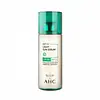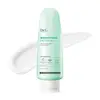What's inside
What's inside
 Key Ingredients
Key Ingredients

 Benefits
Benefits

 Concerns
Concerns

No concerns
 Ingredients Side-by-side
Ingredients Side-by-side

Water
Skin ConditioningDibutyl Adipate
EmollientDiethylamino Hydroxybenzoyl Hexyl Benzoate
UV FilterBis-Ethylhexyloxyphenol Methoxyphenyl Triazine
Skin ConditioningAlcohol Denat.
AntimicrobialNiacinamide
SmoothingButyloctyl Salicylate
Skin ConditioningEthylhexyl Triazone
UV AbsorberButylene Glycol
HumectantEclipta Prostrata Extract
Skin ConditioningMelia Azadirachta Leaf Extract
Skin ConditioningMoringa Oleifera Seed Oil
EmollientPeucedanum Graveolens Extract
TonicCitrus Aurantium Bergamia Fruit Oil
MaskingHibiscus Abelmoschus Seed Extract
MaskingThymus Serpyllum Extract
Skin ConditioningAchillea Millefolium Extract
CleansingAlpha-Arbutin
AntioxidantCrithmum Maritimum Callus Culture Filtrate
Skin ProtectingPhyllanthus Emblica Fruit Extract
HumectantCamellia Sinensis Seed Oil
HumectantCaesalpinia Spinosa Fruit Extract
Skin ProtectingXylitylglucoside
HumectantGossypium Herbaceum Extract
Skin ConditioningKappaphycus Alvarezii Extract
Skin ConditioningXylitol
HumectantYeast Ferment Extract
Skin ConditioningCichorium Intybus Root Extract
MaskingVanilla Tahitensis Fruit Extract
Skin ConditioningOrthosiphon Stamineus Extract
Skin ConditioningThermus Thermophillus Ferment
Skin ConditioningCandida Bombicola/Glucose/Methyl Rapeseedate Ferment
AntimicrobialMentha Suaveolens Leaf Extract
AstringentCamellia Sinensis Leaf Extract
AntimicrobialThymus Vulgaris Leaf Extract
Skin ProtectingImperata Cylindrica Root Extract
Skin ConditioningCalamine
AbsorbentChlorella Ferment
Skin ConditioningHydrolyzed Hyaluronic Acid
HumectantOpuntia Ficus-Indica Stem Extract
Skin ConditioningPanax Ginseng Root Extract
EmollientPerilla Frutescens Extract
Skin ConditioningAdansonia Digitata Seed Extract
Skin ConditioningAdenium Obesum Leaf Cell Extract
MaskingEugenia Caryophyllus Bud Extract
PerfumingSolidago Virgaurea Extract
Skin ConditioningSoluble Collagen
HumectantCaprylyl Methicone
Skin ConditioningHexyl Laurate
EmollientIsoamyl P-Methoxycinnamate
UV AbsorberPolysilicone-15
UV Filter1,2-Hexanediol
Skin ConditioningPentylene Glycol
Skin ConditioningSodium Acrylates Crosspolymer-2
AbsorbentPolymethylsilsesquioxane
Silica
AbrasiveDibutyl Lauroyl Glutamide
Skin ConditioningHydroxyethyl Urea
HumectantIsopropyl Myristate
EmollientSodium Polyacryloyldimethyl Taurate
Emulsion StabilisingDibutyl Ethylhexanoyl Glutamide
Skin ConditioningHydroxyacetophenone
AntioxidantC30-45 Alkyldimethylsilyl Polypropylsilsesquioxane
Trehalose
HumectantAmmonium Acryloyldimethyltaurate/Vp Copolymer
Adenosine
Skin ConditioningPropanediol
SolventAllantoin
Skin ConditioningBiosaccharide Gum-1
HumectantAlbatrellus Confluens Extract
HumectantEthylhexylglycerin
Skin ConditioningCitric Acid
BufferingGlycerin
HumectantAscorbic Acid
AntioxidantMadecassoside
AntioxidantEctoin
Skin ConditioningGlutathione
Hydroxystearic Acid
CleansingPanthenol
Skin ConditioningPhenylethyl Resorcinol
AntioxidantTranexamic Acid
AstringentPalmitoyl Glycine
CleansingEllagic Acid
Skin Conditioning4-T-Butylcyclohexanol
MaskingAnhydroxylitol
HumectantLactic Acid/Glycolic Acid Copolymer
Skin ConditioningCaprylic/Capric Triglyceride
MaskingC12-15 Alkyl Benzoate
AntimicrobialDipotassium Phosphate
BufferingAcetyl Glutamine
Skin ConditioningCerium Oxide
Hydrogen Dimethicone
Triethoxycaprylylsilane
Hydrogenated Lecithin
EmulsifyingHydroxyphenyl Propamidobenzoic Acid
Skin ConditioningBiosaccharide Gum-4
Skin ConditioningCeramide NP
Skin ConditioningMaltodextrin
AbsorbentGluconolactone
Skin ConditioningPolyhydroxystearic Acid
EmulsifyingCaprylyl Glycol
EmollientAscorbyl Palmitate
AntioxidantCellulose Gum
Emulsion StabilisingCalcium Gluconate
HumectantSodium Stearoyl Glutamate
CleansingDisodium EDTA
Xanthan Gum
EmulsifyingSodium Benzoate
MaskingMica
Cosmetic ColorantWater, Dibutyl Adipate, Diethylamino Hydroxybenzoyl Hexyl Benzoate, Bis-Ethylhexyloxyphenol Methoxyphenyl Triazine, Alcohol Denat., Niacinamide, Butyloctyl Salicylate, Ethylhexyl Triazone, Butylene Glycol, Eclipta Prostrata Extract, Melia Azadirachta Leaf Extract, Moringa Oleifera Seed Oil, Peucedanum Graveolens Extract, Citrus Aurantium Bergamia Fruit Oil, Hibiscus Abelmoschus Seed Extract, Thymus Serpyllum Extract, Achillea Millefolium Extract, Alpha-Arbutin, Crithmum Maritimum Callus Culture Filtrate, Phyllanthus Emblica Fruit Extract, Camellia Sinensis Seed Oil, Caesalpinia Spinosa Fruit Extract, Xylitylglucoside, Gossypium Herbaceum Extract, Kappaphycus Alvarezii Extract, Xylitol, Yeast Ferment Extract, Cichorium Intybus Root Extract, Vanilla Tahitensis Fruit Extract, Orthosiphon Stamineus Extract, Thermus Thermophillus Ferment, Candida Bombicola/Glucose/Methyl Rapeseedate Ferment, Mentha Suaveolens Leaf Extract, Camellia Sinensis Leaf Extract, Thymus Vulgaris Leaf Extract, Imperata Cylindrica Root Extract, Calamine, Chlorella Ferment, Hydrolyzed Hyaluronic Acid, Opuntia Ficus-Indica Stem Extract, Panax Ginseng Root Extract, Perilla Frutescens Extract, Adansonia Digitata Seed Extract, Adenium Obesum Leaf Cell Extract, Eugenia Caryophyllus Bud Extract, Solidago Virgaurea Extract, Soluble Collagen, Caprylyl Methicone, Hexyl Laurate, Isoamyl P-Methoxycinnamate, Polysilicone-15, 1,2-Hexanediol, Pentylene Glycol, Sodium Acrylates Crosspolymer-2, Polymethylsilsesquioxane, Silica, Dibutyl Lauroyl Glutamide, Hydroxyethyl Urea, Isopropyl Myristate, Sodium Polyacryloyldimethyl Taurate, Dibutyl Ethylhexanoyl Glutamide, Hydroxyacetophenone, C30-45 Alkyldimethylsilyl Polypropylsilsesquioxane, Trehalose, Ammonium Acryloyldimethyltaurate/Vp Copolymer, Adenosine, Propanediol, Allantoin, Biosaccharide Gum-1, Albatrellus Confluens Extract, Ethylhexylglycerin, Citric Acid, Glycerin, Ascorbic Acid, Madecassoside, Ectoin, Glutathione, Hydroxystearic Acid, Panthenol, Phenylethyl Resorcinol, Tranexamic Acid, Palmitoyl Glycine, Ellagic Acid, 4-T-Butylcyclohexanol, Anhydroxylitol, Lactic Acid/Glycolic Acid Copolymer, Caprylic/Capric Triglyceride, C12-15 Alkyl Benzoate, Dipotassium Phosphate, Acetyl Glutamine, Cerium Oxide, Hydrogen Dimethicone, Triethoxycaprylylsilane, Hydrogenated Lecithin, Hydroxyphenyl Propamidobenzoic Acid, Biosaccharide Gum-4, Ceramide NP, Maltodextrin, Gluconolactone, Polyhydroxystearic Acid, Caprylyl Glycol, Ascorbyl Palmitate, Cellulose Gum, Calcium Gluconate, Sodium Stearoyl Glutamate, Disodium EDTA, Xanthan Gum, Sodium Benzoate, Mica
Water
Skin ConditioningCellulose
AbsorbentDipropylene Glycol
HumectantGlyceryl Caprylate
EmollientAcrylates/C10-30 Alkyl Acrylate Crosspolymer
Emulsion StabilisingCaprylyl Glycol
EmollientAllantoin
Skin ConditioningPanthenol
Skin ConditioningPolyglyceryl-10 Laurate
Skin ConditioningPropanediol
SolventArginine
MaskingDisodium EDTA
Glycerin
Humectant1,2-Hexanediol
Skin ConditioningButylene Glycol
HumectantSodium Hyaluronate
HumectantGlycosphingolipids
EmollientHydroxypropyltrimonium Hyaluronate
Ascorbic Acid
AntioxidantHydrolyzed Hyaluronic Acid
HumectantSodium Acetylated Hyaluronate
HumectantHyaluronic Acid
HumectantHydrolyzed Sodium Hyaluronate
Skin ConditioningSodium Hyaluronate Crosspolymer
HumectantPotassium Hyaluronate
Skin ConditioningWater, Cellulose, Dipropylene Glycol, Glyceryl Caprylate, Acrylates/C10-30 Alkyl Acrylate Crosspolymer, Caprylyl Glycol, Allantoin, Panthenol, Polyglyceryl-10 Laurate, Propanediol, Arginine, Disodium EDTA, Glycerin, 1,2-Hexanediol, Butylene Glycol, Sodium Hyaluronate, Glycosphingolipids, Hydroxypropyltrimonium Hyaluronate, Ascorbic Acid, Hydrolyzed Hyaluronic Acid, Sodium Acetylated Hyaluronate, Hyaluronic Acid, Hydrolyzed Sodium Hyaluronate, Sodium Hyaluronate Crosspolymer, Potassium Hyaluronate
 Reviews
Reviews

Ingredients Explained
These ingredients are found in both products.
Ingredients higher up in an ingredient list are typically present in a larger amount.
1,2-Hexanediol is a synthetic liquid and another multi-functional powerhouse.
It is a:
- Humectant, drawing moisture into the skin
- Emollient, helping to soften skin
- Solvent, dispersing and stabilizing formulas
- Preservative booster, enhancing the antimicrobial activity of other preservatives
Allantoin is a soothing ingredient known for its protective and moisturizingg properties. Because of this, it is often added to products with strong active ingredients.
Studies show higher concentrations of this ingredient can promote wound healing.
Though it can be derived from the comfrey plant, allantoin is produced synthetically for cosmetic products to ensure purity.
Learn more about AllantoinAscorbic Acid is is pure Vitamin C. This form makes up the largest amount of vitamin C found naturally in our skin.
Not only is vitamin C great for your overall health and immune system, it also has plenty of benefits on your skin.
Vitamin C is best used for brightening skin. It improves dark spots, acne scars, and hyperpigmentation. This is because it blocks the process of skin darkening when exposed to UV.
Remember: Vitamin C should not replace sunscreen!
Your skin uses vitamin C to build collagen. Collagen is one key component in having a strong skin barrier and plump skin. Vitamin C also plays a role in regulating collagen, thus making it effective in improving wrinkles and fine lines.
Ascorbic acid shows potent antioxidant activity. As an antioxidant, it helps fight free-radicals. Free-radicals are molecules that may damage your skin cells. These antioxidants also protect skin against UV damage.
The best formulations include Vitamin E and/or ferulic acid. These two ingredients help stabilize and provide a boost in the benefits of ascorbic acid. This is because ascorbic acid becomes unstable when exposed to UV and air. In fact, you can tell your ascorbic acid has oxidized when it turns an orange-yellow color.
Ascorbic acid is generally compatible with other ingredients. However, using ascorbic acid with other active ingredients might cause irritation. Two ingredients: copper ions and benzoyl peroxide, will inactivate ascorbic acid completely.
Read more about other types of Vitamin C:
Foods rich with vitamin C include oranges, strawberries, broccoli, bell peppers, and more. When consuming Vitamin C, your skin receives a portion of the nutrients.
Learn more about Ascorbic AcidButylene Glycol (or BG) is used within cosmetic products for a few different reasons:
Overall, Butylene Glycol is a safe and well-rounded ingredient that works well with other ingredients.
Though this ingredient works well with most skin types, some people with sensitive skin may experience a reaction such as allergic rashes, closed comedones, or itchiness.
Learn more about Butylene GlycolCaprylyl Glycol is a humectant and emollient, meaning it attracts and preserves moisture.
It is a common ingredient in many products, especially those designed to hydrate skin. The primary benefits are retaining moisture, skin softening, and promoting a healthy skin barrier.
Though Caprylyl Glycol is an alcohol derived from fatty acids, it is not the kind that can dry out skin.
This ingredient is also used as a preservative to extend the life of products. It has slight antimicrobial properties.
Learn more about Caprylyl GlycolDisodium EDTA plays a role in making products more stable by aiding other preservatives.
It is a chelating agent, meaning it neutralizes metal ions that may be found in a product.
Disodium EDTA is a salt of edetic acid and is found to be safe in cosmetic ingredients.
Learn more about Disodium EDTAGlycerin is already naturally found in your skin. It helps moisturize and protect your skin.
A study from 2016 found glycerin to be more effective as a humectant than AHAs and hyaluronic acid.
As a humectant, it helps the skin stay hydrated by pulling moisture to your skin. The low molecular weight of glycerin allows it to pull moisture into the deeper layers of your skin.
Hydrated skin improves your skin barrier; Your skin barrier helps protect against irritants and bacteria.
Glycerin has also been found to have antimicrobial and antiviral properties. Due to these properties, glycerin is often used in wound and burn treatments.
In cosmetics, glycerin is usually derived from plants such as soybean or palm. However, it can also be sourced from animals, such as tallow or animal fat.
This ingredient is organic, colorless, odorless, and non-toxic.
Glycerin is the name for this ingredient in American English. British English uses Glycerol/Glycerine.
Learn more about GlycerinHydrolyzed Hyaluronic Acid is a form of hyaluronic acid. It is created by the hydrolysis of hyaluronic acid with a high molecular weight. Once created, Hydrolyzed Hyaluronic Acid has a low molecular weight.
Low molecular weight HA has been shown to hydrate and increase elasticity of the skin. Increasing elasticity is also associated with reduction of wrinkle depth.
One study found topical low molecular weight hyaluronic acid may be considered for the treatment of rosacea in the adult population. However, we always recommend speaking with a professional about your skin concerns.
Hyaluronic acids are a humectant. This means they draw moisture from the air. Hyaluronic acids help moisturize, soothe, and protect the skin.
Read more about other common forms of hyaluronic acid:
Learn more about Hydrolyzed Hyaluronic AcidPanthenol is a common ingredient that helps hydrate and soothe the skin. It is found naturally in our skin and hair.
There are two forms of panthenol: D and L.
D-panthenol is also known as dexpanthenol. Most cosmetics use dexpanthenol or a mixture of D and L-panthenol.
Panthenol is famous due to its ability to go deeper into the skin's layers. Using this ingredient has numerous pros (and no cons):
Like hyaluronic acid, panthenol is a humectant. Humectants are able to bind and hold large amounts of water to keep skin hydrated.
This ingredient works well for wound healing. It works by increasing tissue in the wound and helps close open wounds.
Once oxidized, panthenol converts to pantothenic acid. Panthothenic acid is found in all living cells.
This ingredient is also referred to as pro-vitamin B5.
Learn more about PanthenolPropanediol is an all-star ingredient. It softens, hydrates, and smooths the skin.
It’s often used to:
Propanediol is not likely to cause sensitivity and considered safe to use. It is derived from corn or petroleum with a clear color and no scent.
Learn more about PropanediolWater. It's the most common cosmetic ingredient of all. You'll usually see it at the top of ingredient lists, meaning that it makes up the largest part of the product.
So why is it so popular? Water most often acts as a solvent - this means that it helps dissolve other ingredients into the formulation.
You'll also recognize water as that liquid we all need to stay alive. If you see this, drink a glass of water. Stay hydrated!
Learn more about Water